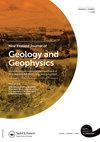新西兰南岛塔斯曼湾东南部海岸-近海Waimea-Flaxmore断裂系统的构造演化、分段和活动性
IF 1.9
4区 地球科学
Q1 GEOLOGY
New Zealand Journal of Geology and Geophysics
Pub Date : 2023-10-04
DOI:10.1080/00288306.2023.2260768
引用次数: 0
摘要
摘要通过塔斯曼湾深度转换地震线与陆上剖面连接的6个区域断面,分析了从Nelson-Richmond市区到D 'Urville岛的Waimea-Flaxmore断层系统(W-FFS)。在约19-10 Ma的断裂传播褶皱机制下,沿断裂系统的整个长度发生了西- ffs基底断裂的反向再激活。然而,西- ffs仅在苏西斯角附近向南至尼尔森岸上保持第四纪活跃,而塔斯曼湾东部自7 Ma以来就停止了活动。西侧断裂带不活跃的西部断裂被新发现的c. E-W、Croisilles断裂带、Cross Point和D 'Urville断裂带分割,累计右偏移量约为27 km。c. E-W断裂从陆上延伸到塔斯曼湾,被解释为马尔伯勒断裂系统的最北端晚中新世链,在夏洛特女王断裂带北部的地壳块体中容纳了早期的分布剪切。在澳-太平洋板块边界大尺度运动的驱动下,西- ffs的分割和沿走向变化发生在陆上Nelson收缩域向北部Marlborough走滑域的过渡阶段。关键词:Waimea-Flaxmore断层系统活动断层褶皱地震线nelson塔斯曼湾d 'urville岛马尔堡南岛感谢I. Hamling提供的塔斯曼湾InSAR测量数据和J. Ristau帮助定位塔斯曼湾的一些地震。P. Barnes, G. Browne, D. Eberhart-Phillips和S. Nodder的评论和建议极大地改进了论文的早期草稿。我们感谢J. Scott、H. Seebeck和一位匿名审稿人所做的编辑修改和建设性的批评。披露声明作者未报告潜在的利益冲突。数据可用性声明支持本研究结果的数据在补充文件1中提供(尼尔森市Waimea-Flaxmore断层系统的地质环境的详细描述,随附地质图和图S1-1的横截面);补充文件2(以相同比例尺复制地质样条T1-T6的大格式tiff文件);补充文件3(讨论了机械弱点和流体超压在Waimea-Flaxmore断裂系统继承断层活化中的作用,附图S3-1)。补充材料可以在https://doi.org/10.6084/m9.figshare.23612340.v1.Additional的figshare上公开获取。这项工作是由terrage私人资助的。纳尔逊市议会和塔斯曼区议会出资收购地图出版商(Avenza System)软件,用于地质制图。本文章由计算机程序翻译,如有差异,请以英文原文为准。
Structural evolution, segmentation and activity of the onshore-offshore Waimea-Flaxmore Fault System in south-eastern Tasman Bay, South Island, New Zealand
ABSTRACTThe Waimea-Flaxmore Fault System (W-FFS) from the Nelson-Richmond urban area to D’Urville Island is analysed through six regional transects that join depth-converted seismic lines in Tasman Bay to onshore cross sections. Reverse reactivation of basement faults of the W-FFS by mechanisms of fault-propagation folding at c. 19-10 Ma occurred along the entire length of the fault system. However, the W-FFS remained Quaternary active only from the vicinity of Cape Soucis southwards into onshore Nelson, in contrast with cessation of activity along eastern Tasman Bay since 7 Ma. The inactive western faults of the W-FFS are buried below Plio-Quaternary marine sediments and segmented by the newly identified, c. E-W, Croisilles Fault Zone, Cross Point and D’Urville faults, with cumulative dextral offset of c. 27 km. The c. E-W faults extend from the onshore into Tasman Bay and are interpreted as the northernmost Late Miocene strands of the Marlborough Fault System that have accommodated incipient distributed shear in the crustal block north of the Queen Charlotte Fault Zone. Segmentation and along-strike changes of the W-FFS occur at the transition from the contractional domain of onshore Nelson to the northern Marlborough strike-slip domain, driven by large-scale kinematics of the Australia-Pacific plate boundary.KEYWORDS: Waimea-Flaxmore Fault SystemActive faultsFoldsSeismic linesNelsonTasman BayD’urville IslandMarlboroughSouth IslandNew Zealand AcknowledgementsWe thank I. Hamling for providing data on InSAR measurements in Tasman Bay and J. Ristau for help with locating some earthquakes in Tasman Bay. Comments and suggestions of P. Barnes, G. Browne, D. Eberhart-Phillips and S. Nodder greatly improved an early draft of the paper. We gratefully acknowledge the editorial revisions and constructive criticism provided by J. Scott, H. Seebeck and an anonymous reviewer.Disclosure statementNo potential conflict of interest was reported by the author(s).Data availability statementData that support the findings of this study are provided in Supplemental File 1 (detailed description of the geological setting of the Waimea-Flaxmore Fault System in Nelson City, with accompanying geological map and cross sections of Figure S1-1); Supplemental File 2 (large format tiff files of geological transects T1-T6 all reproduced at the same scale); and Supplemental File 3 (discussion on the role of mechanical weakness and fluid overpressure on reactivation of the inherited faults of the Waimea-Flaxmore Fault System, with accompanying Figure S3-1). The supplementary material is openly available in figshare at https://doi.org/10.6084/m9.figshare.23612340.v1.Additional informationFundingThis work was privately funded by TerraGeologica. Nelson City Council and Tasman District Council funded acquisition of the Map Publisher (Avenza System) software, used for geological mapping.
求助全文
通过发布文献求助,成功后即可免费获取论文全文。
去求助
来源期刊
CiteScore
5.10
自引率
27.30%
发文量
34
审稿时长
>12 weeks
期刊介绍:
Aims: New Zealand is well respected for its growing research activity in the geosciences, particularly in circum-Pacific earth science. The New Zealand Journal of Geology and Geophysics plays an important role in disseminating field-based, experimental, and theoretical research to geoscientists with interests both within and beyond the circum-Pacific. Scope of submissions: The New Zealand Journal of Geology and Geophysics publishes original research papers, review papers, short communications and letters. We welcome submissions on all aspects of the earth sciences relevant to New Zealand, the Pacific Rim, and Antarctica. The subject matter includes geology, geophysics, physical geography and pedology.

 求助内容:
求助内容: 应助结果提醒方式:
应助结果提醒方式:


